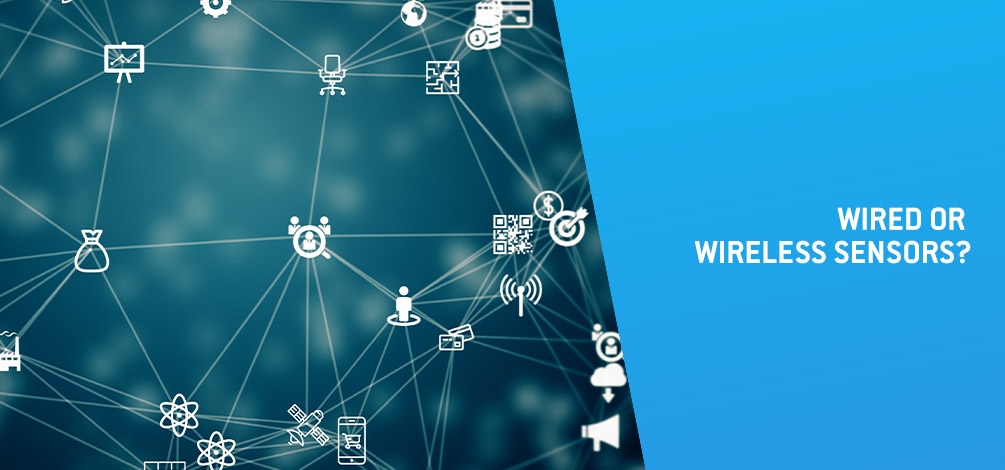WIRED OR WIRELESS SENSORS?

Data is an added value element that will bring advantages in the creation, monitoring and management of production processes.
We are witnessing a growing stage of technology presence in the several global economic sectors. Different industries and markets have evolved and become more efficient based on what today and certainly in the future assume one of the biggest roles in technological advancement…the information.
The raw data collection process is now taken over by sensors with characteristics specific to the environment in which will be installed. Data is an added value element that will bring advantages in the creation, monitoring and management of production processes. The market comes with many formats and types of sensors, but they all fall into one of these levels: wired or wireless.
Before moving on to choosing the type of technology you want, it is important to carefully consider which one best suit your business – which area do I want to cover with monitoring? Does the infrastructure allow a secure installation of a wired solution? Will there be changes in infrastructure in a short time? If I need to redesign the workspaces, will i have problems with sensor replacement?
The key question is to know the specifications of the facilities and which type of monitoring to apply. Wired and wireless sensors have their advantages and disadvantages, but it is essential to realize that there will be no significant difference between these two categories that previously made one solution unfeasible over the other. Knowing these aspects will help you make a more informed decision that offers the desired financial return from facility optimization.
WIRED SENSORS
ADVANTAGES
- Security: the security level offered by a wired system is one of its biggest advantages. Reliable wiring in local network infrastructures, usually operating behind firewalls, switches and other technological solutions, prevents data from being improperly intercepted, collected and tampered with;
- Speed / Reliability: Due to the physical nature of exclusive access to the communication channel, technological maturity and protocol diversity, it is expected and possible to achieve higher speed and reliability than in wireless systems, due to the technological nature. Wireless sensors are subject to interferences from both infrastructure (walls, cabinets, etc.) and environment (other electronic devices). Data transmission over wires ensures superior speed and is not subject to as much interference as wireless systems;
- Profitability / Cost: The costs of wired solutions are still more attractive than opting for a wireless system. The uptime of these solutions is relatively long as they do not require an external power supply, effectively reducing the maintenance times imposed on these systems;
DISADVANTAGES
- Mobility: The physical part of this system is one of the biggest disadvantages. The physical structure imposed by using cabling required for connections turns its inherent lack of flexibility in a time-consuming process for changes and restructuring;
- Installation costs: the installation costs associated with the application of wired sensors are related to the size of the area to be monitored, the number of devices required and above all the access to the internal network and all the necessary wiring;
- Cable damage: Use of cables increases the risk of occurrences that could disable the connection. Damage or disconnection can be caused by many factors and are more susceptible to human error or work around. In the worst-case scenario, you will need to replace the communication cable, forcing an increased maintenance cost;
WIRELESS SENSORS
ADVANTAGES
- Flexibility: Adapting a wireless system proves to be most efficient, primarily due to the absence of cables. The simple installation of wireless devices adds to this technology the mobility necessary to prevail over the option of using cables;
- Network upgrades: Although some sensors still require individual network configuration, many already operate with network-aware plug & play systems that automatically connect. Most newly developed wireless devices include in their specifications some essential networking features such as self-healing, self-optimizing and path redundancy that effectively ensure information distribution;
- Accessibility: Wireless systems capture data that can be accessed from multiple devices at different locations by adding technologies that are adaptable to these solutions. IoT platforms are the most recurring systems to complete the applications of wireless sensors;
- Scale: Setting up a wireless monitoring system becomes more practical regardless of the area where it is applied. The easy installation of wireless devices makes it easy to properly cover the entire area. Connecting multiple transmitters to a link node, such as gateways and repeaters, makes it easy to expand your network;
DISADVANTAGES
- Configuration: It remains a disadvantage that can make the user choose another option. The device configuration process is dependent on variables and specifications that require more advanced knowledge than user optics;
- Battery life: Using batteries as the primary power source for wireless devices sets a mandatory maintenance cost. Despite the technological advances achieved in the development of batteries, their duration will always be related to the communication technologies used by the devices and the defined transmission frequency suitable to the installation environment;
- Speed / interference: Under normal conditions, excluding the dependency associated with the type of wireless solutions used and the communication protocols involved, the data transmission speed in wireless systems is lower than the wired system by technology-specific definitions. For wireless sensors, this speed may change due to signal interference or the distance between communication points being a limiting factor. Communication occurs through a shared environment (air), where privacy and information integrity are a constant concern;
FINAL CONCLUSIONS
The choice of using a wireless system will make monitoring a simpler and more evolutionary process, with a more advanced technological dimension, merged by the IoT concept, which brings a new highlight to the information collected by the sensors. Assimilating the relevance that continuous monitoring has on your market and business model remains the basis for choosing wired or wireless monitoring solutions.